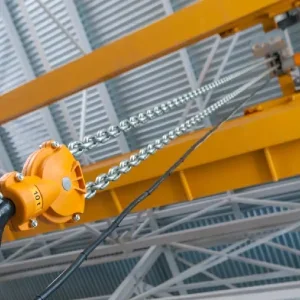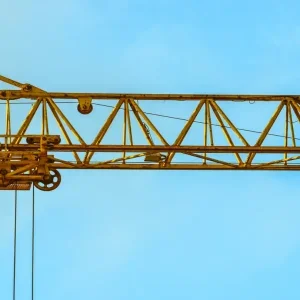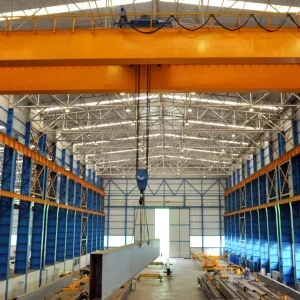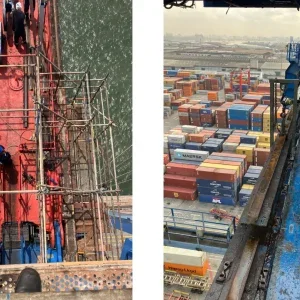The lead theme at CeMat 2016 was “Smart Supply Chain Solutions”, reflecting the growing trend towards digital integration and Industry 4.0 and it was a focus in evidence among the hoist and crane component exhibitors from around the world.
Whether it was a “black box” for a hoist or a smarter remote control, the emphasis was very much on enabling customers to collect more data from their machines in order to increase efficiency and provide a safer working environment.
Among those manufacturers that have developed a “black box” is Spanish company GH Cranes & Components, which launched its CoreBox at CeMat.
CoreBox records all the lifting data from a hoist or crane, from the weight of the lift to the number of lifts as well as engine temperature and service and maintenance information. The data can be accessed via USB, or any wireless or 3G device.
Marketing manager Garbiñe Guerra said there were about 50 in the market and next year CoreBox would be offered as standard with all products.
“Data collection and monitoring is the future for us,” she said.
Turkish manufacturer KM Kümsan produces a black box. Assistant general manager Inan Gökyer, said: “Customers want more and more information. They want to see the state of their product and to have more control.”
Jaso Industrial Cranes plans to have a black box on the market in the next few months. Export area manager Daniel Leunder said the device would be standard on all new cranes.
“Customers want to analyse their process and the information received will also help us develop new products,” he said. CeMat has always been a great day for product launches.
Columbus McKinnon Industrial Products presented two new products: the Yale ERGO360 ratchet lever hoist and a highcapacity addition to its CPV range of electric chain hoists.
The ERGO306, the highlight on the company’s stand, was developed following an ergonomic study by an independent institute linked to the University of Wuppertal, Germany.
It features a crank handle that provides a 360° operation, allowing a lifting speed 12 times faster than standard lever hoists, and reducing pulling forces by up to 30%. It is available in 0.75t, 1.5t and 3t capacities. The ERGO360’s light weight means it can be carried using the crank handle as grip. Overload limiter, shipyard hooks and RFID chips are available as accessories.
Swedish manufacturer Gunnebo Industries used CeMat to launch a lifting point range which it said offers “a solution for every lifiting application,” and the ROV Retrieve shackle for subsea lifting and rigging operations.
International sales manager Mikael Lähdesmäki said the new products continued Gunnebo’s philosophy of improving efficiency for the end user. The new lifting range consists of four types: the Rotating Lifting Point (RLP); the Rotating Eye Lifting Point (RELP); the De-centered Lifting Point (DLP); and the Ballbearing Lifting Point (BLP), all available in sizes up to M48.
Gunnebo has offered the RLP for many years but it’s been improved so the bow rotates 360° and pivots 180°.
“It has an open D-ring so it can be hooked onto the master link so it saves putting in shackles,” said Lähdesmäki. The RELP provides a single point lift. It automatically adjusts to the loading direction, reducing the risk of loading it incorrectly.
The DLP’s compact design makes it ideal for narrow spaces and the folding link means it can be stowed when not in use. The link also has a “stay up” function which provides the dual benefits of easy onhooking and no rattling when it’s attached to vibrating machines or vehicles.
The BLP allows the load to be rotated during the lift or put on its side.
The new ROV Retrieve shackle aims to make the remotely operated vehicle’s (ROV) rigging operation safer and more efficient, particularly when retrieving and lifting objects from the seabed. It has no loose parts, in its closed or open position, removing the need for wires or monkey fists.
Under the slogan “noticeably different… by far better,” German manufacturer Rud presented six product developments at the show, all in the company’s distinctive pink livery.
Using its patented ICE bolt material Rud has increased the loading capacities of its VLGB load rings while maintaining the same thread diameter. The new VLGB-Plus load ring is available in steel grades of M8 to M30.
In the two years since Rud introduced the ICE-LBG with ballbearing at CeMat 2014 it has increased the working load capacity by 45%. Like its predecessor, the ICE-LBGSR is used where loads need to be rotated. The Automatic Center Point automatically adjusts itself to the load optimal position in case of lateral loading and, in combination with the ICE bolt, the WLL values could be increased by more than 50% compared to products of a similar design.
The Safety Tex Point is made from ultra high-tensile yarn to provide a sling point solution for surfaces that could be damaged by metal parts.
Rud also presented a new version of its weldable, rigid suspension eye ABA sling point. The B-ABA “nicely shaped bolting version” is offered in sizes from 1.6t to 31.5t. The sixth new product was the Novelty crossbars and spreaders for the lightest ICE sling chains. Made of extruded, high-tensile plastic profiles glued with profile-stiffening composite parts, the crossbars and spreaders are available up to 3m in length and WLL of 3t.
Rud was also promoting the Rud Portal, an online archive file for hoist chain certificates. Following 14 months of market research, JD Neuhaus presented the concept of its new stainless steel air hoist to CeMat visitors. The company expects to release the product by the end of the year.
The hoist is aimed at extremely clean environments such as the food and drinks industry, chemical and pharmaceutical companies, and clean rooms in medical and aerospace technology.
“Because the product is stainless steel no bacteria can lie on it and there is no paint to flake off,” said international sales manager Daniel Gregel.
The exhaust air is extracted externally, the chain has a protective covering and food grade oil is used.
While the launch of its black box may be a few months away, at CeMat, Spanish manufacturer Jaso did introduce its V range of hoists up to 100t capacity which features a lifting frequency inverter. Its existing N range has a two-speed motor. Jaso also promoted its crane kit, which aims to reduce the costly business of transporting cranes. Jaso ships the trolley with the hoist end carriage and electric cabinet and provides the drawings for the girder design, which is made on site. Other new products Jaso is working on are rechargeable inverters and a gantry crane with a pneumatic wheel.
The main attractions on Vetter’s stand were the new DowelPlate system and the Unilift slewing jib crane.
The DowelPlate has an elastic supporting surface of levelling buffers and can be installed directly onto a floor without the need for foundation works. “Because the customer doesn’t have to put down a foundation it’s easy and fast to install and the cost is reduced,” said export manager Ines Reichmann.
The Unilift has an aluminium jib arm for handling small loads up to 1t and is aimed at sectors such as logistics and car parts manufacturing.
Among the Chinese manufacturers exhibiting at CeMat was Vitali-International Until now the company has produced manual chain hoists for the US, Europe and Asia but next year it will start production of electric chain hoists. This was one of the reasons it was at the show.
“We want to show customers that we have the ability for product development,” said managing director Dennis Wong. He added that the company’s 25,000 sq m factory in Zhejiang was one of the most hi-tech in the province.
Elephant Chain Block was one of the few, if not the only, Japanese exhibitors. The family-owned company highlighted some new electric chain and manual chain hoists which are smaller in size but with larger lifting capacities.
“Our new 1t manual chain hoist is the same size as our old 0.5t,” said managing director Harumasa Tsuda.
In the Japanese market these hoists are used in the construction of timber-framed buildings and in work areas with low elevation.
Taking pride of place on Tele Radio’s stand was the Tiger Tablet, which the Swedish company launched at this year’s Bauma. The transmitter interfaces wirelessly with an existing PLC/PC and the built-in remote control connects with the receiver through radio communication. It provides real-time data such as weight, camera feeds and alarm and the housing can accommodate any standard Android or Apple tablet.
Market manager Arne Hagen said the company had received 400 leads following the Bauma launch and he believed the product had “a lot of potential”, particularly for automatic and processing cranes.
“It will become commonplace on applications where you need to see what’s happening behind or under the crane,” he said. It was fitting that French company Comege should demonstrate its workshop motorised gantry crane with a wine barrel as the load. International area manager Jean-Michel Hirtz said the crane had been well received and 20 had been sold since it was launched at the start of the year. Hirtz said it differed from similar cranes by having the capacity to move a load up to 6.3t, with a 6m height and 10m span, by rolling and turning in every direction.
“There’s no need to modify the building as you don’t need a strong structure. All you need is a smooth floor,” he said. Comege exports to distributors in 27 countries and it was hoping to attract new partnerships at CeMat.
In the spirit of Industry 4.0, German engineering company GKN Stromag launched its condition monitoring solutions for braking systems. It notifies any faults via a tablet or smartphone, and used in conjunction with the company’s Smart Cam it shows the height of the load and an overspeed system controls the speed of the lift. It can also transmit information to the maintenance team.
The monitoring system can be connected to all types of cranes and Airbus in France has been using it for four months. GKN Stromag also launched two pieces of kit. The B2F-B brake is a spring-applied electromagnetic fail safe brake with a modular design, while the TDXB caliper thruster disc brake is aimed at heavy-duty operations such as steel mills.
It is available in two sizes and the only maintenance required is replacing the brake pads.
Spanish company Elebia is set to expand into new markets with the launch of its e2, 10 years after it developed its first remote hook prototype.
The company already has 5t, 10t and 20t hooks and the e2, which can lift up to 2.5t, is aimed at customers with smaller capacity needs.
“It will take the remote hook into new markets where there are space limitations or price sensitivities,” said CEO and founder Oscar Fillol Vidal.
While the industry was launching new release systems, Vidal said they solved “only half the problem”.
“It affects productivity as the crane has to stop to load and wait for the rigger to hook and release and this happens several times a day,” he said.
The next step, he added, would be a smart hook that transmitted data.
“The hook has to be an information system so it has to be aware of what we are transporting because that affects the flow in the factory. It has to be able to weigh the load and provide information if something is going wrong,” said Vidal. “At the moment the sensors are on the pulleys or wires but that’s not always accurate.”
Elebia is working on streamlining customers’ logistics further by including RFID.
“With RFID you know what you are moving, you can weigh it so you don’t have to take products out of the process. The hook is doing some of this but at the moment it is a dream,” said Vidal.
On its stand Elebia also promoted its eMax remote control system. It has a full colour LCD screen and provides the user with information about the lift, including weight, hook status and alarms that alert the operator to a problem.
Liftket used CeMat to introduce customers to its new ultra-flat twin chain hoist for low headroom spaces. It features a 180mm headroom and 4t capacity. Tom Schumann, managing director of Liftket India, said the company supplies hoists to German TBM manufacturer Herrenknecht and the new ultra-flat model was ideal for tunnel construction.
On its stand Italian manufacturer Autec displayed its new generation of remote controls.
In response to customers asking for larger displays, the joystick versions now feature bigger, full colour screens, technical sales and service manager Manfred Pauli explained.
The push button remotes have also been updated to make the buttons easier to use and allow greater customisation. An infrared receiver can also be added, Pauli said.
Austrian chain manufacturer Pewag featured its PeTAG product identification system. It enables operators and auditors to access service and maintenance information online.
Sales manager Wolfgang Ullrich said that for customers, the system was efficient and low cost.
“It avoids the need for paperwork and customers don’t need a software licence. The price is based on the number of objects the program is used for,” he said. In the open air area forklift manufacturer Combilift demonstrated its new Straddle Carrier Tilter (Combi-SC Tilter).
The new machine, a progression of the Combi-SC that handles containers and out of gauge loads, has been designed specifically for the recycling industry and scrap yards.
The Combi-SC Tilter is described by Combilift as “a one-machine solution for two specific and differing applications”: offloading and tipping bulk materials where a container needs to be tipped to 75° and loading bulk where containers need to be upended to 90°. The turning radius is less than 7.5m.
A weight measurement system fitted to the two Combi-SC models meets the International Maritime Organisation’s SOLAS (Safety Of Life At Sea) requirements, which came into force on July 1. At Cemat the 30,000th Combilift to roll off the production lines was handed over to steel construction company Haslinger Stahlbau.
Combilift’s new €40m, 46,000sq m plant in Monaghan, Ireland is due to open next year and is part of the company’s strategy to double its current €150m turnover by 2020.






